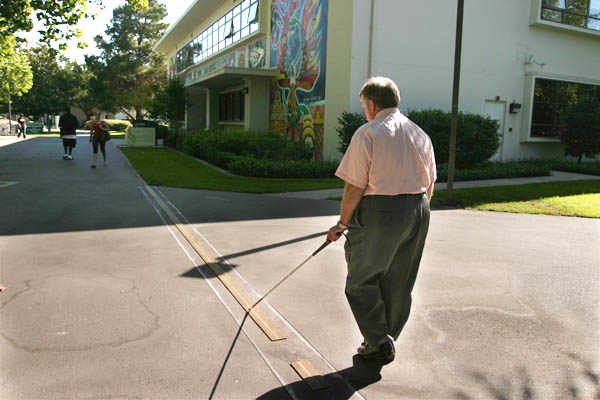Access for blind students

Sacramento State Disability Management Counselor Gene Lazano uses his cane and yellow guide strips to navigate his way around the Sac State campus.:
October 14, 2008
Imagine not being able to see and having to walk around the 300-acre Sacramento State campus. Not an easy feat for those who are blind or sight-impaired.
Gene Lozano, disability management counselor and access specialist for Sac State, who is blind, has had to deal with finding his way around the campus for the past 27 years.
Lozano said he started receiving complaints from blind students in 1990 because they were having a hard time navigating around the campus. The students said getting off at the bus stop on J Street and walking around the library quad area was confusing, and they often lost their sense of direction. They also complained about getting lost trying to find Lassen Hall.
Lozano worked for the County of Sacramento before coming to Sac State and assisted developing a guide strips program for the county.
The bright, yellow guide strips also assist students who are sight-impaired. The yellow is easy to see and helps the students identify where they are going.
The blind students at Sac State knew about Lozano’s knowledge of the guide strips and asked him to have them installed on campus. In 1991, Lozano worked with the school’s facilities and had yellow guide strips installed along the pathways for the students.
“Using guide strips allows students to travel independently,” said Lozano. “Fortunately we are a flat campus, but a very large campus, so it is easy to get lost.”
Recently, students have come to Lozano complaining many of the strips originally installed need to be repaired. Parts of the strips are missing, and in some cases, no longer rise above the cement sidewalks. The students also want strips installed in the back area of the campus where there are no strips.
There are approximately 30 blind and sight-impaired students now at Sac State, according to the Services to Students with Disabilities Office.
Lozano said some of the outside maintenance contractors who have worked on the campus in the past are unfamiliar with guide strips and remove them or make them even with the ground because they see them as a tripping hazard.
“Students are getting impatient because the existing strips still need repairing,” Lozano said. “Walking around the library is like walking on a concrete prairie.”
Ron Richardson, associate vice-president for Facility Services, said new guide strips are being added this fall. The university will be replacing the worn and missing strips. Richardson said he noticed several hundred feet of guide strips installed a number of years ago are coming up. Richardson said additional strips will be installed in a number of areas.
‘The strips need to be maintained, so that students have a cognizant map of the campus they can follow,” Lozano said.
In 1991, when the guide strips were first installed, Lozano and Robin Lovering, Manager of Project Design & Development for Sac State, walked around campus determining where to place them. Their focus was to have a main path of travel easy to follow with minimum contact for students not using the strips.
Richardson is working with Eicher, and Lozano, on the new project to make sure the strips are being placed where they are most beneficial to the students. The guide strips will be placed on each side of the walk paths and added to areas of the campus in the back of the school.
The facilities team under Richardson will do the work instead of an outside contractor because Richardson said they can get the job done faster and their work is better quality.
Eicher said it would cost $50,000 to replace and install the new guide strips. Eicher and Lozano said this project in no way affects the money used for students or staffing.
Although the Americans with Disabilities Act does not require the yellow guide strips, Richardson said facilities’ goal is to fix problems before they happen. Richardson said facilities works on balancing between what should be repaired and what can be added to improve things each year.
Lozano said there are other options for the sight-impaired. The problem is they are more costly and in some cases too sophisticated for the students to use.
One option is talking signs. Two devices are required to use talking signs: A transmitter, which is attached to a building with an infrared beam, and a hand-held receiver to receive a signal from the transmitter. As the student walks closer to the building, the sound from the transmitter becomes louder, guiding the student to the building. The cost of a transmitter is around $250 and it would be needed for each building on campus. Students would then have to buy a hand-held receiver, which costs around $150.
Another possibility is a GPS system. The student would have to learn how to use it while walking with a cane. The costs to the individual student would run around $3000.
“The goal is to give every student on campus not only access to programs but access to buildings,” said Lozano.
Sally King can be reached at [email protected]












































































































































